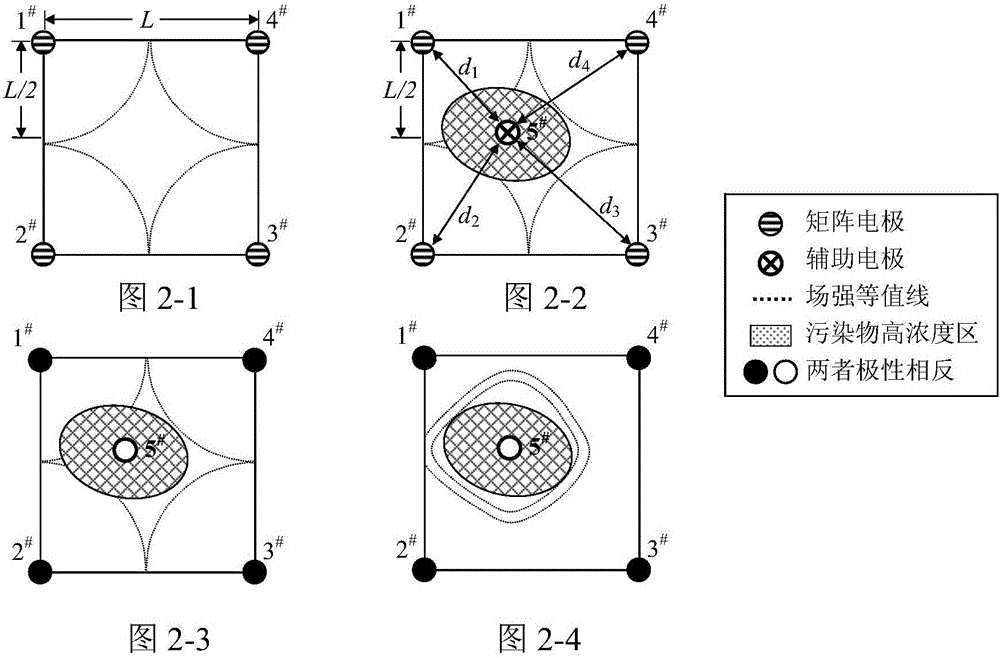Field intensity compensation method for constructing inhomogeneous field through auxiliary electrode
A non-uniform electric field and auxiliary electrode technology, applied in the fields of botanical equipment and methods, restoration of polluted soil, biocides, etc., can solve the problems of large spatial variability of residues and inability to achieve the remediation efficiency of organic contaminated soils. Achieve the effect of improving the overall space repair efficiency, solving the contradiction of the consistency of removal efficiency, and avoiding spatial differences
- Summary
- Abstract
- Description
- Claims
- Application Information
AI Technical Summary
Problems solved by technology
Method used
Image
Examples
Embodiment 1
[0050] The contaminated soil repaired in this example is the oil-contaminated soil configured in the laboratory. The soil collected is clay, and the impurities and grass roots visible to the naked eye are removed. After being naturally air-dried indoors, it is passed through a 2mm sieve. Oil pit, mixed into 40g / kg~50g / kg oil-contaminated soil, let it air-dry for 7 days, after the oil and soil are evenly mixed, use deionized water to adjust the moisture content to 25%, and put it into the electric repair reaction tank Inside (20cm long x 20cm wide x 15cm high).
[0051] The spatial distribution of the concentration of petroleum pollutants was collected in the reaction tank through the grid method, and a total of 25 samples (5×5) were collected. Infrared spectrophotometry was used to measure the concentration of petroleum pollutants into oil content mean μ=44.5g / kg, standard deviation δ=7.2g / kg, and spatial variation coefficient CV=16.2%. Taking the sum of the mean value and th...
Embodiment 2
[0067] The difference from Example 1 is:
[0068] The mean value of oil content of the concentration of petroleum pollutants is μ=34.3g / kg, the standard deviation δ=8.8g / kg, and the spatial variation coefficient CV=25.7%. Taking the sum of the mean value and the standard deviation of the pollutant concentration, that is, μ+δ=43.1g / kg as the threshold, the spatial distribution of the pollutant concentration is divided into a high-concentration area and a low-concentration area. Among them, the high concentration area accounts for 20.7% of the total area, and the low concentration area accounts for 79.3% of the total area.
[0069] Such as figure 2 middle diagram 2-1 ~ figure 2 As shown in -4, in this embodiment, due to the distance relationship between the auxiliary electrode and the matrix electrode, it satisfies Therefore, if figure 2 As shown in -3, assume that the polarity of the matrix electrodes is the same, and the polarity of the auxiliary electrode is opposit...
PUM
 Login to View More
Login to View More Abstract
Description
Claims
Application Information
 Login to View More
Login to View More - Generate Ideas
- Intellectual Property
- Life Sciences
- Materials
- Tech Scout
- Unparalleled Data Quality
- Higher Quality Content
- 60% Fewer Hallucinations
Browse by: Latest US Patents, China's latest patents, Technical Efficacy Thesaurus, Application Domain, Technology Topic, Popular Technical Reports.
© 2025 PatSnap. All rights reserved.Legal|Privacy policy|Modern Slavery Act Transparency Statement|Sitemap|About US| Contact US: help@patsnap.com



